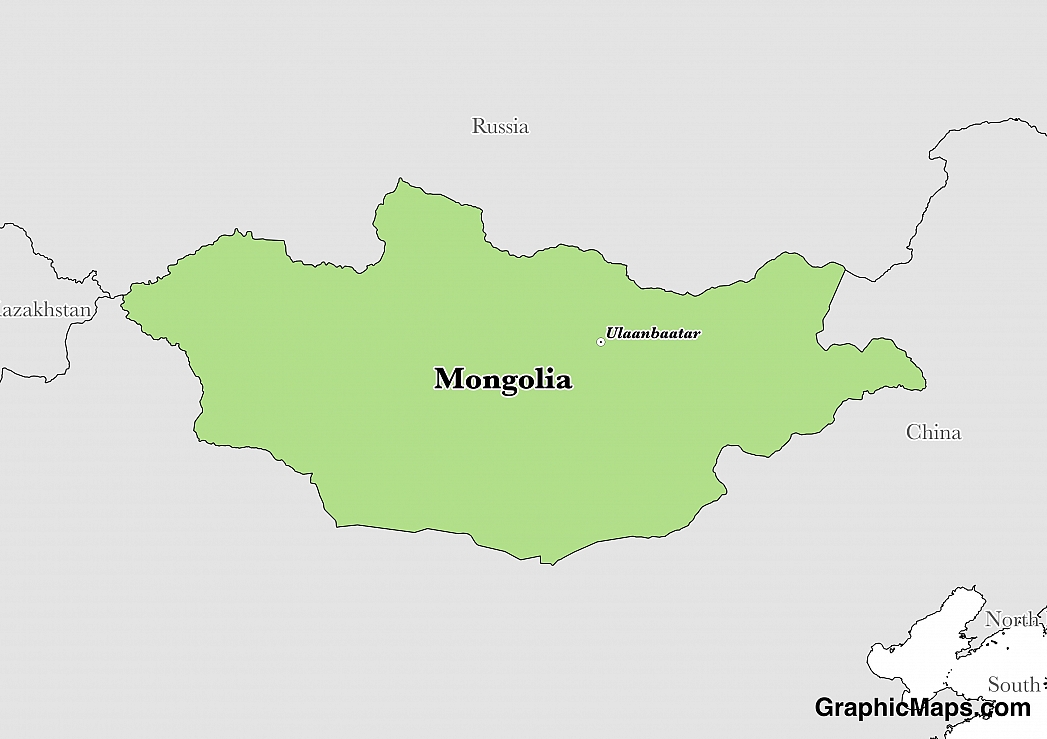Where is Mongolia?
Located in Northern Asia, Mongolia has a 8,082.00 km border with China (4,630 km) and Russia (3,452 km).
The capital city of Mongolia is Ulaanbaatar, located in the northern-central region of the country, and represents the largest city in the nation. The city was founded in 1639 as a Buddhist community for travellers to the region and was known as Ulan Bator. In 1778, the city was permanently anchored to the current location having changed location over 25 times in the time between 1639-1778. Ulaanbaatar lies at a location of 1,300 metres (4,300 feet) and represents the cultural, financial, and industrial centre of Mongolia.
Read more on Mongolia's CapitalMongolia is an Asian country covering 1,564,116.00 km2 of which 0.68% is water and 1,553,556.00 km2 is land. This makes it the 18th largest country in the world and slightly smaller than Alaska; more than twice the size of Texas. Its geographic coordinates are 46 00 N, 105 00 E and Ulan Bator is the capital city.
The name Mongolia means "Land of the Mongols".
Its ISO code is MN.
Geography
Mongolia has a mean elevation of 1,528 m above sea level.
It has a desrt climate with large temperature ranges. Its terrain consists of semidesert and desert plains, with narrow coastal plains and high limestone mountains and plateaus.
Population
Mongolia has a population of 3,031,330 making it the 138th largest in the world. The country is sparsely populated throughout.
Mongolian is the official and most widely spoken language. The major ethnic group is Khalkh. The majority of the country is Buddhist or non-identifying.
The official language of Mongolia is Mongolian, the modern dialect of which originated in the 13th and 14th Century during the Mongol Empire. Mongolian was found to be related to an extinct language that was known as Khitan after previous opinions of the language being related to Turkic, Japanese, or Korean were debunked. Written literature in the language has existed since the 13th century but this is seen as an evolution of the Khitan language. Mongolian has a complex evolution and history and is one of the oldest living languages on the planet. Approximately 95% of the country speaks Mongolian as a native language which equates to roughly 2.95 million people.
Read more on Mongolia's LanguagesThe dialing code for the country is 976.
Government
Mongolia is an independent country. It gained independence from China in 1911. Its constitution was last ratified in 1992.
The political system of Mongolia takes place in a semi-presidential representative democracy within a republic consisting of multiple political parties and ideologies. Executive power is held by the President of Mongolia and the government and legislative power is vested in both the government and parliament. The judiciary system of Mongolia is independent of the government and parliament. The national parliament of Mongolia is known as the State Great Khural and is located in the capital city of Ulaanbaatar in a facility known as Government Palace.
Read more on Mongolia's GovernmentEconomy
Factoring in Purchasing Power Parity, Mongolia's GDP is $37,000,000,000.00 (USD) with $12,200.00 (USD) per capita. This makes it the 120th largest economy and its citizens the 120th richest in the world. The currency of Mongolia is the Tugrik (MNT).
Its major export partners are China and Switzerland. Its main exports are copper, apparel, livestock, and animal products. Its major import partners are China, Russia, and Japan. Its major imports include machinery and equipment, fuel, cars, food products, and industrial consumer goods.
Flag
The flag of Mongolia consists of three horizontal bands, all of equal size, of red, blue, and red. The Soyombo national symbol is depicted in yellow within the red band on the left-hand side of the flag. This version of the flag was adopted on 12 February 1992 after the Mongolian Revolution of 1990 had spurred the transition of the country to a liberal democracy. The current flag of the nation is very similar to the version used from 1945-1992 with slight variances in colour and the removal of the socialist star which sat atop the Soyombo national symbol. The red in this flag is a symbol of the spirit of the Mongolian people and their will to survive and thrive in a harsh environment and the blue is said to be symbolic of the eternal blue sky that is seen in Mongolia. The Soyombo national symbol consists of a column arrangement of symbols that represent the sun, moon, yin-yang symbol (known as taijitu), earth, as well as fire and water. As mentioned, the flag of Mongolia used from 1945-1992 is very similar to the current banner. However, the blue in this version is a lot lighter and there is a star (a symbol of socialism in Mongolia) above the Soyombo national symbol. The Bogd Khaanate of Mongolia used three separate flags from 1911-1924 with all three containing portions, or the whole, of the Soyombo national symbol.
Read more on Mongolia's FlagThis page was last modified on February 6th, 2018
More on Graphicmaps

Published on 2019-11-06
What is a Trade Embargo?

Published on 2019-11-04
Which Two Countries Used to Have the Same Flag?

Published on 2019-09-16
What Is the Only Two-Sided State Flag?

Published on 2019-09-16
Which Country Flag Looks Like the Texas Flag?

Published on 2019-08-29
Flags That Resemble the US Flag

Published on 2019-08-20
